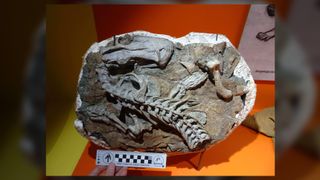Monstrous 'gorgons' survived a mass extinction, but they were a 'dead clade walking'
About 90% of all species went extinct during the "Great Dying" around 252 million years ago, but in the case of one paleo-beast — the so-called gorgon — reports of its death were greatly exaggerated, new research finds.

Reports of a "gorgon" mass extinction at the end of the Permian period were greatly exaggerated, new research finds. These bizarre paleo-beasts were thought to have died out along with most other life on Earth at the time, but scientists recently found that some of these so-called gorgons survived into the Triassic period. However, they didn't survive long, making them a "dead clade walking," the team said.
An analysis of three specimens found in the Karoo Basin in South Africa reveals that this saber-toothed group, known as gorgonopsians, the dominant predators during the late Permian period, managed to survive the "Great Dying." During this event, which took place around 251.9 million years ago and was also known as the end-Permian extinction, about 90% of all species went extinct. Gorgonopsians were an exception — but despite their survival, their prospects weren't great.
"'Dead clade walking' is a term used in extinction studies that refers to when a group of organisms technically survives a mass extinction, but is so damaged by it that they never recover, and linger on for a little bit before finally disappearing," project co-researcher Christian Kammerer, the research curator of paleontology at the North Carolina Museum of Natural Sciences in Raleigh, told Live Science in an email.
Dead clades walking may last millions of years after a mass extinction "but never re-diversify or attain substantial abundance in ecosystems, so they are effectively already 'dead' from a macroevolutionary perspective," he explained.
The research was presented Nov. 3 at the Society of Vertebrate Paleontology's annual conference in Toronto and has yet to be published in a peer-reviewed journal.
Related: Ancient saber-toothed 'gorgons' bit each other in ritualized combat

Gorgonopsians — named after the mythical and monstrous Greek gorgons, whose looks could turn people to stone — existed long before the dinosaurs emerged during the Triassic about 240 million to 230 million years ago.
Sign up for the Live Science daily newsletter now
Get the world’s most fascinating discoveries delivered straight to your inbox.
The researchers were aware of a partial gorgonopsian skull from the Karoo Basin dating to the Triassic period's Induan age (251.9 million to 251.2 million years ago). Other researchers had dismissed that skull, thinking it had been misidentified or incorrectly dated. But a new investigation revealed that it was "definitely a gorgonopsian," possibly from the genus Cyonosaurus, said Kammerer and lead author Julien Benoit, a senior researcher of paleontology at the Evolutionary Studies Institute of the University of the Witwatersrand in Johannesburg.
Then, the duo analyzed two additional specimens, likely also members of Cyonosaurus, from the Karoo Basin. Of the three gorgonopsian specimens, two are from sites spanning the Permo-Triassic boundary, and the third is from an early Triassic layer.

It's possible that Cyonosaurus survived the mass extinction due to its small size, abundance and flexible diet. The fox-size carnivore — which sported a snout that was narrow, elongated and packed with teeth — was one of the smallest known gorgonopsians on record. Small, generalist predators typically adapt better to changing ecosystems than large, specialist predators do and are therefore more likely to weather catastrophic events, Kammerer said. "So if there was any gorgonopsian that we would expect might survive into the Triassic, it would be Cyonosaurus," he said.
After the mass extinction, biodiversity crashed in the Karoo Basin, and an herbivorous, tusked animal called Lystrosaurus, which lived during parts of the Permian and Triassic, skyrocketed in numbers, "So, Cyonosaurus likely did not run out of preys," Benoit told Live Science in an email.
Research is ongoing, and "further scrutiny of these sites is necessary," the team said. But the data indicate that gorgonopsians survived into the earliest part of the Triassic, which is about as surprising as a tyrannosaur surviving the asteroid slamming into Earth, the scientists joked in their conference abstract.
That said, Triassic gorgonopsians were rare and from a single genus, so this dead clade walking "should still be considered a victim of the end-Permian mass extinction," the researchers said.

Laura is the archaeology and Life's Little Mysteries editor at Live Science. She also reports on general science, including paleontology. Her work has appeared in The New York Times, Scholastic, Popular Science and Spectrum, a site on autism research. She has won multiple awards from the Society of Professional Journalists and the Washington Newspaper Publishers Association for her reporting at a weekly newspaper near Seattle. Laura holds a bachelor's degree in English literature and psychology from Washington University in St. Louis and a master's degree in science writing from NYU.
-
JackofManyTrades As a kid, I only thought about dinosaurs. But years ago when I heard of the Permian creatures, I was blown away. An entirely different dominant lineage (synapsids I think) ruled the Earth, and to be the first on land, for tens of millions of years. The Gorgonopsians are as weird as they are terrifying to contemplate.Reply
